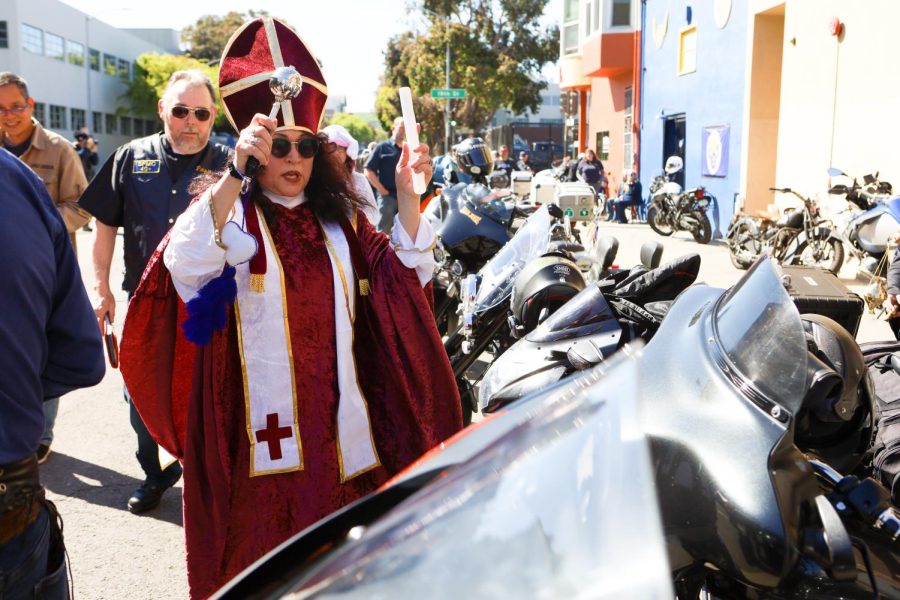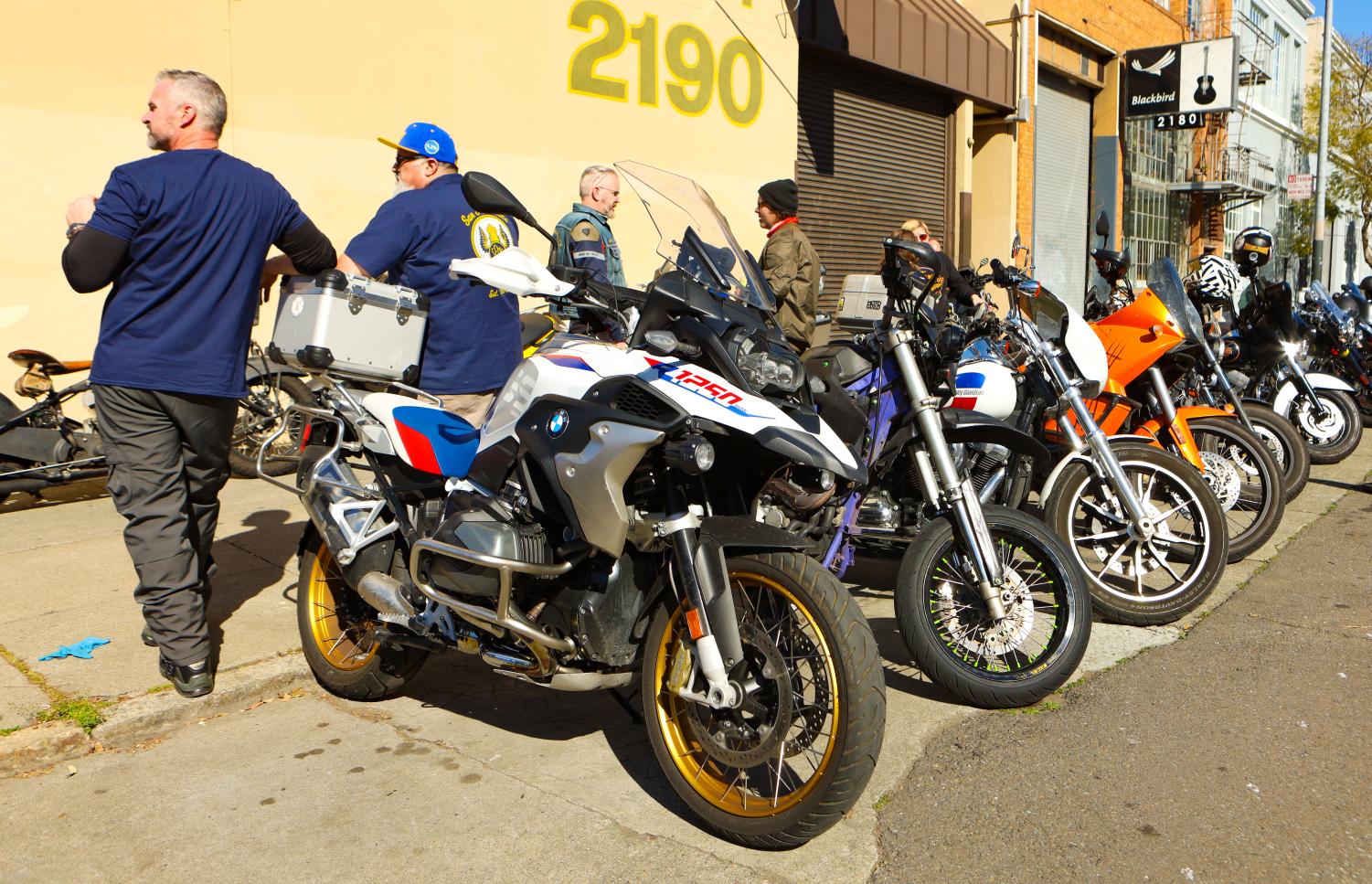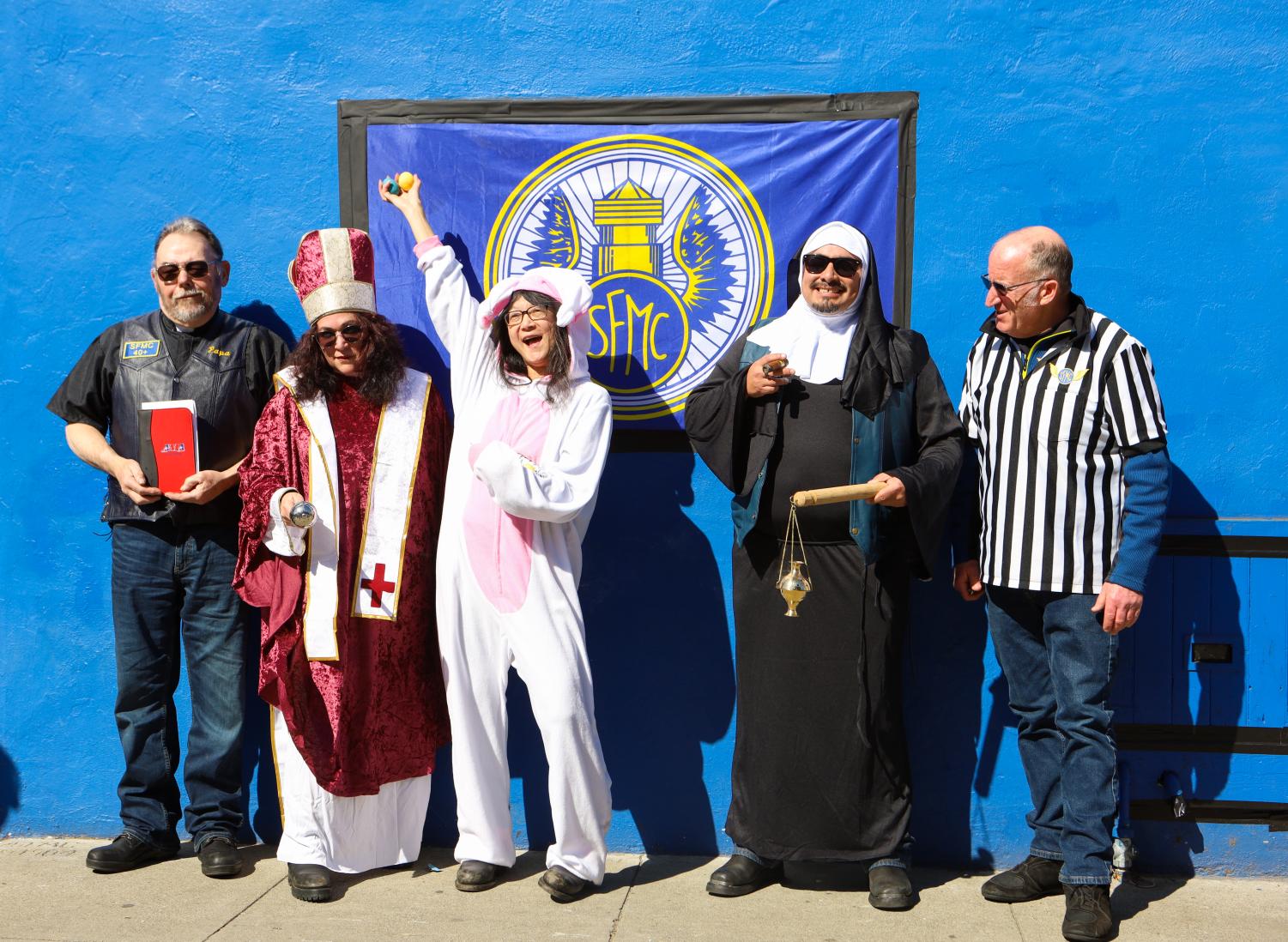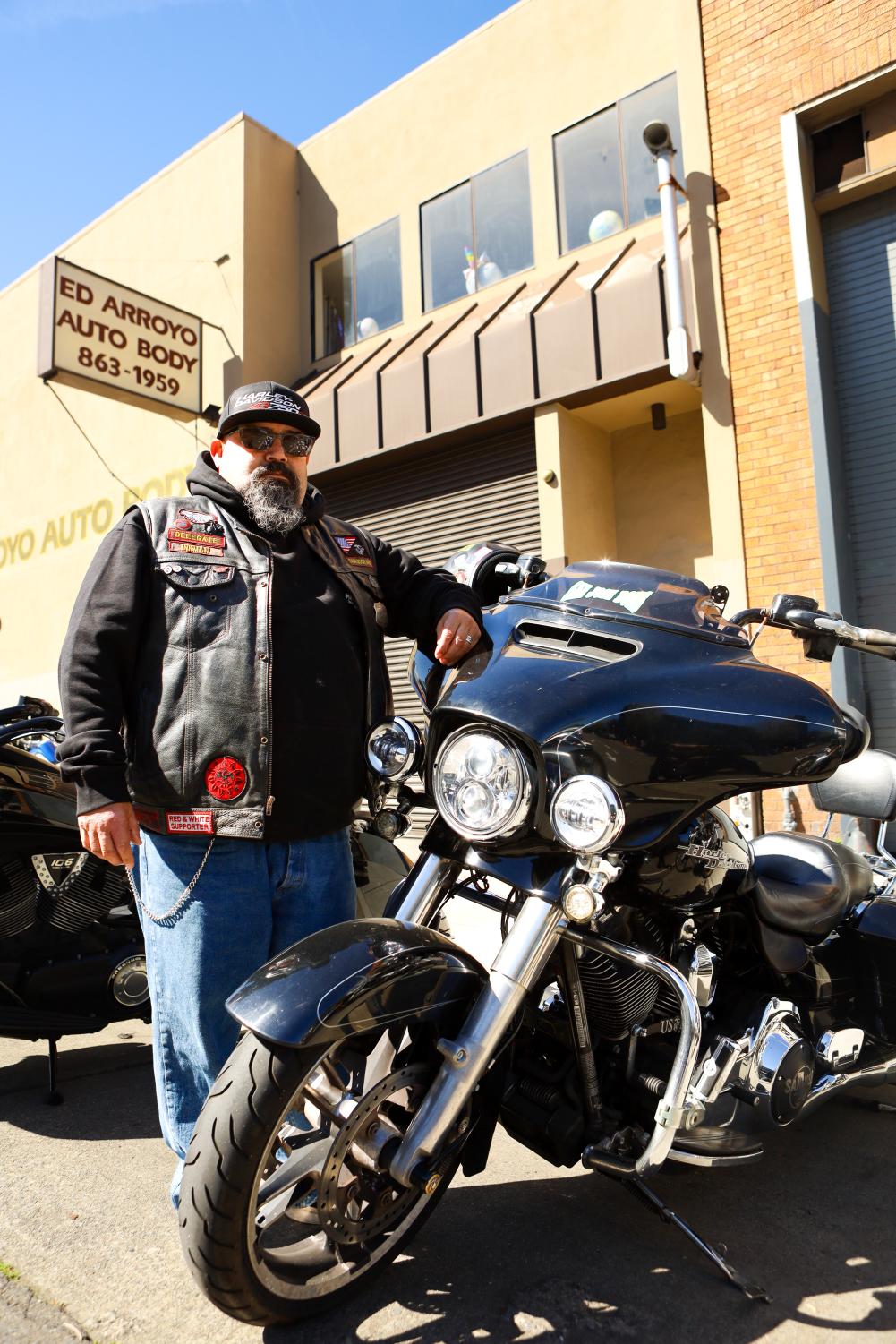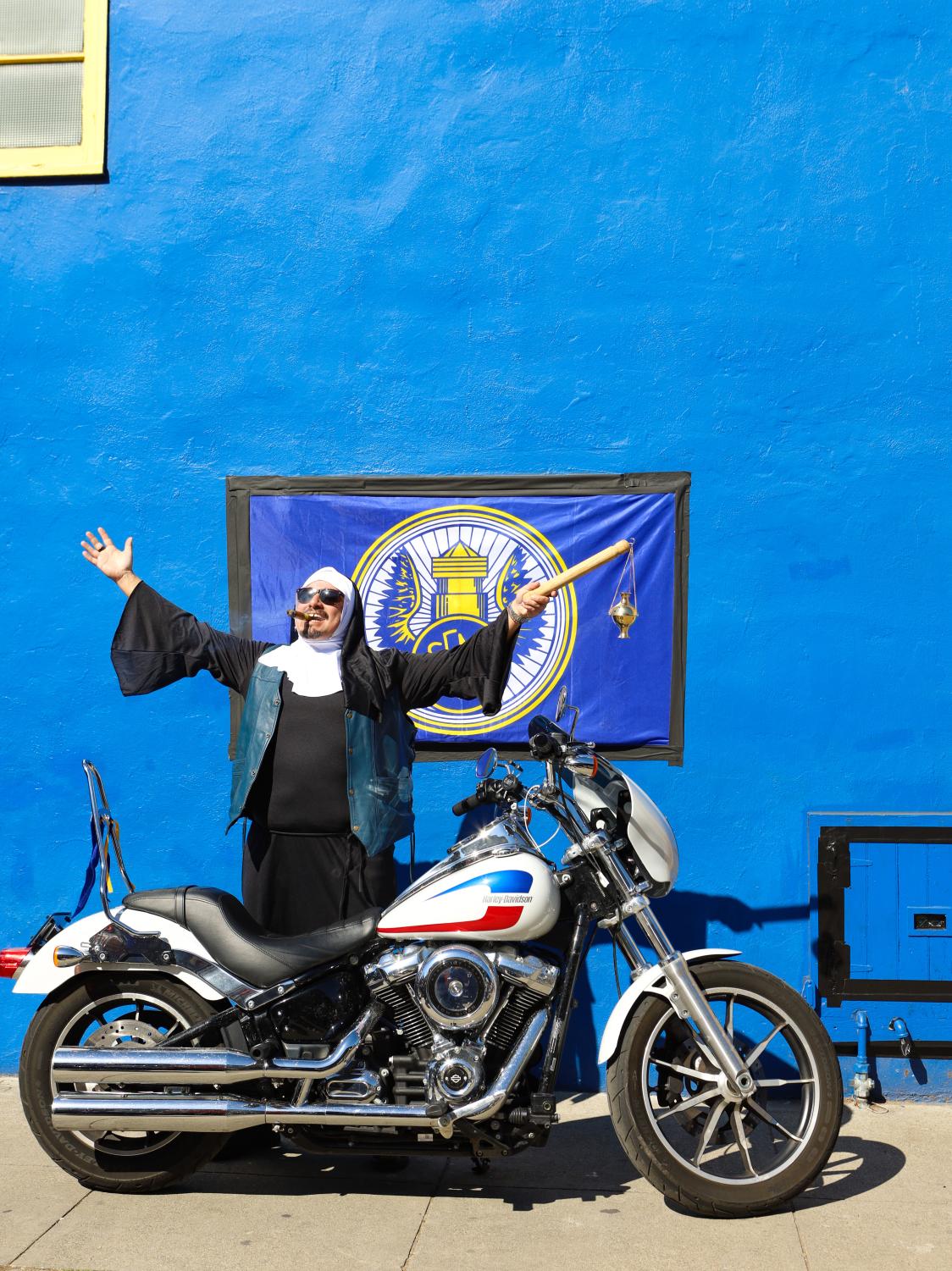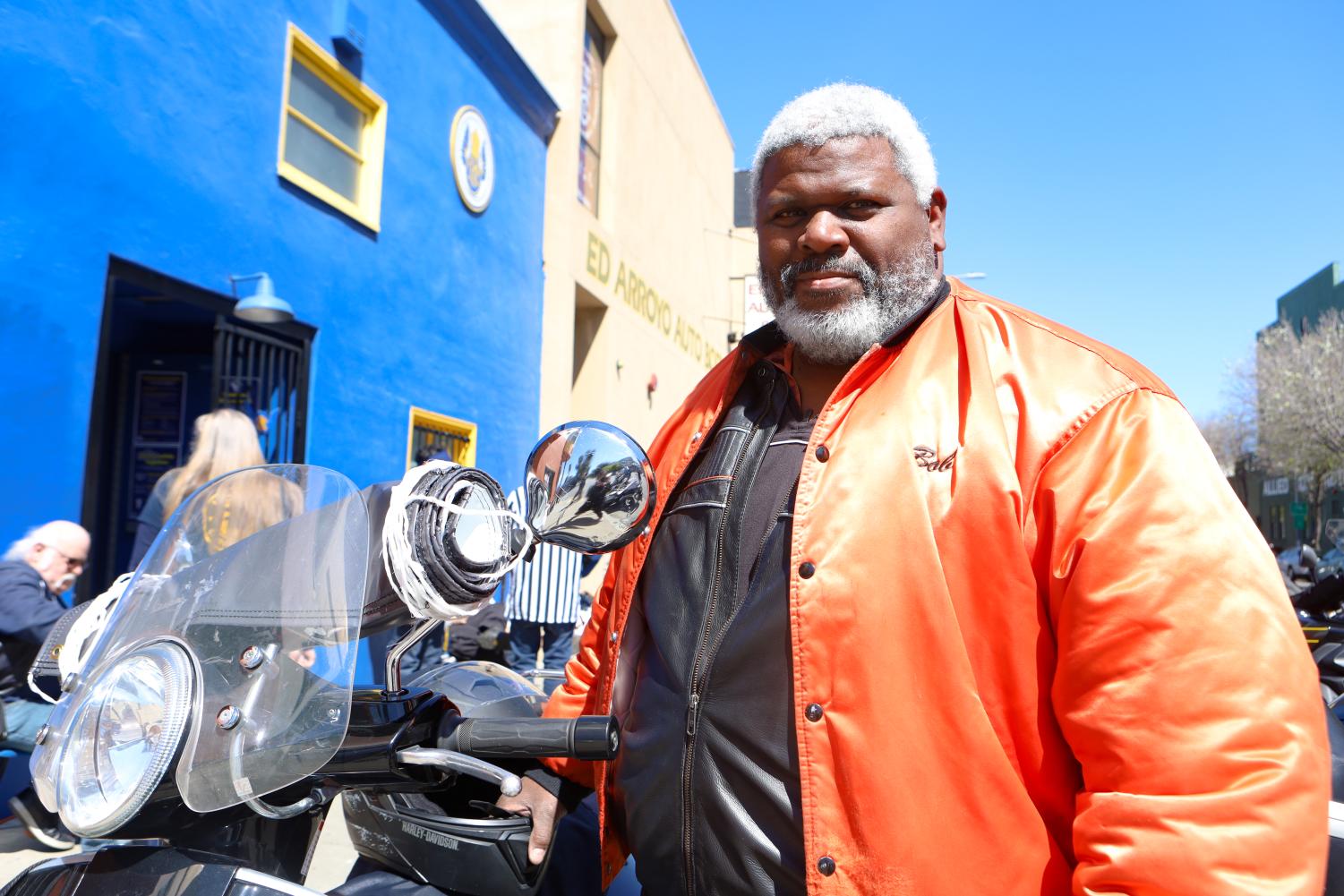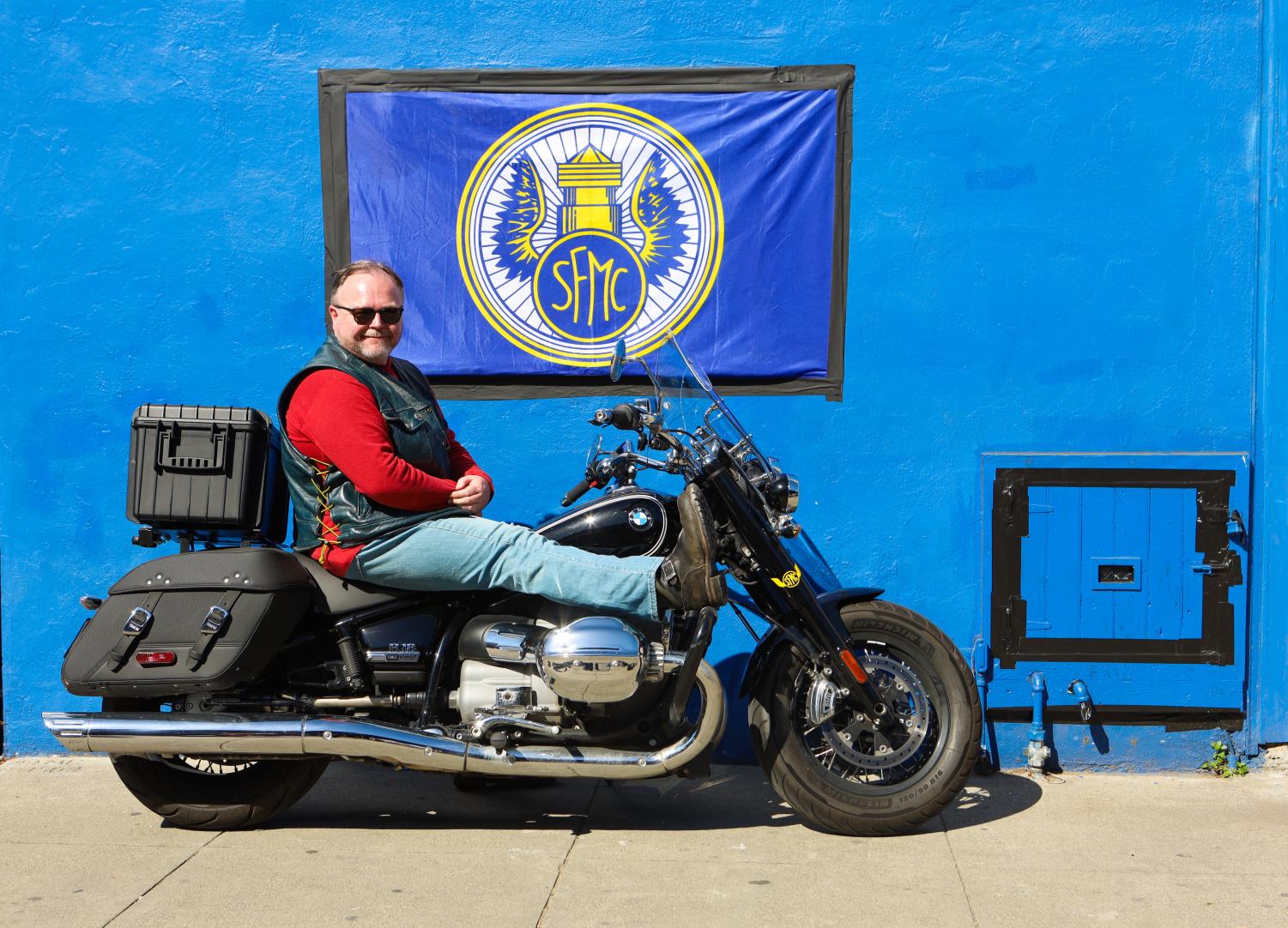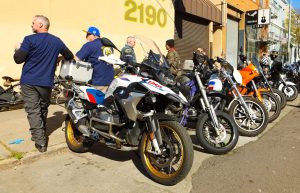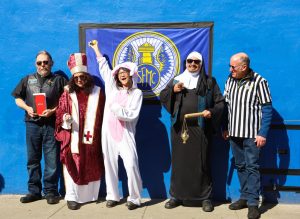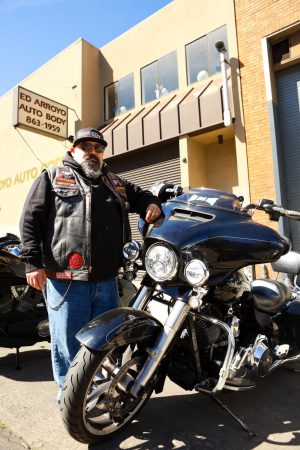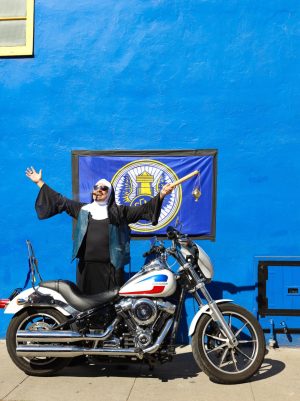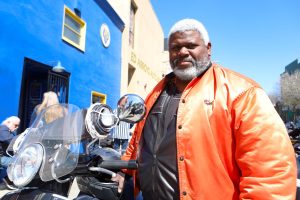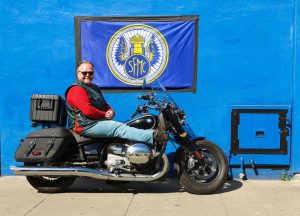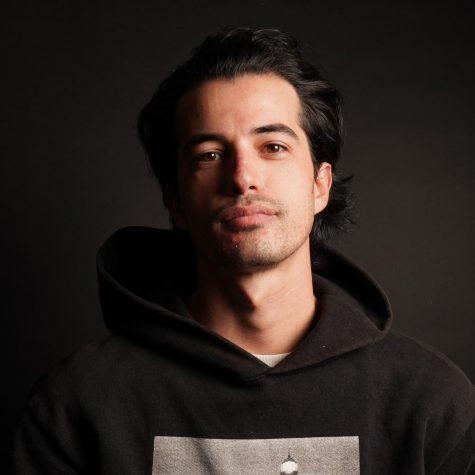A Ride Down Memory Lane
A look inside the heart, and driving force, of San Francisco’s oldest motorcycle club.
Miriam Moody, dressed as a bishop, blesses the bikes lined up outside of the San Francisco Motorcycle Clubhouse. Moody spent two years around the club before prospecting in 2019. She had her official initiation on this day, due to the pandemic disrupting the regular club initiation during her initial prospecting period. (Gina Castro / Xpress Magazine)
It’s Easter Sunday — early, and the sun has not yet risen. Motorcyclists donned in leather vests adorned with blue and gold SFMC patches get on their bikes parked in a line in front of 2194 Folsom St. They’re heading for the top of Mount Tamalpais in Marin, just north of the Golden Gate Bridge. The San Francisco Motorcycle Club pulls out in a staggered formation — cruising their bikes down the center lane of the highway, loud in the early morning fog of the Golden Gate — out to revive an eighty-year-old tradition of riding and blessing bikes with blasphemy to usher in this year’s riding season. Led by Ride Capitan Vince Torrano and followed by seasoned riders such as Club President Jane Williamson, Vice President Dave “Papa” Schiller and Brian Holm, the SFMC Easter Ride begins.
Walking into the clubhouse is akin to walking into a museum — through the front door of the unassuming blue building, the long wood-paneled hall is lined with photographs and mementos recalling memories from the late 1800s, decades before the club’s inception. The names and faces immortalized on the wall are some of the most influential early motorcyclists, and the history of the club is something that all current members first mention upon first stepping through the doors. Brian Holm, SFMC member and historian, is eager to take new visitors through the history of the club. Founded in 1904, it is the second oldest, continuously operating Motorcycle Club in the country. Holm’s well-rehearsed tour lasts roughly two and a half hours, according to him, and club members jokingly add that they need to install a self-guided audio tour guests can interact with.
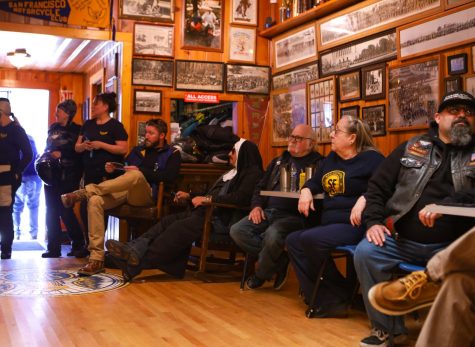
“I was hanging out at the clubhouse, not yet a member,” Holm said, “and I would ask questions about the photos and never really get a clear answer as to what was in the early photographs. So I took it upon myself to research the history of the club and its early members and create the timeline you see hanging here today.”
Before the 1900s, the club, in its early stages, began as bicyclists in San Francisco that would group together to ride and compete in track races.
According to Holm, these men were badass. They would ride miles on the Ordinary bike, or Penny-farthing (picture a monocled Victorian man on a bike with a large front wheel). The first motorcycles, according to club history, were two-manned motorized bikes that were used as pacers to bring the Ordinary bike up to top speed in track races. As motorcycle technology advanced and more were sold to the public, it did not take long for them to catch on.
The club was founded by some of the earliest motorcycle dealers in San Francisco. Twelve members were in attendance for the first meeting, including C.C. “Daddy” Hopkins, James Tormey, George Payton, Joe Holle, Harry Rockwell and Al Freed.
By 1910, the club was holding regular meetings in dealerships such as Thor Motorcycle Shop. On April 16, 1906, SFMC held its first dance at its new Jefferson Square hall, and mere hours after it concluded, the Great Earthquake leveled most of the city and fires destroyed the club. As the club rebuilt and the membership grew larger, the club of pioneers began introducing women to their ranks. Women maintained a seat at the table, and the earliest photographs of the club included women riders. In 1910, the SFMC made it official and became the first motorcycle club to admit women members. At this time, women were allowed to vote on club matters a decade before they were allowed to vote in federal elections. By 1911, with the addition of women members, the club’s active member count peaked at 500. This progressive history is something that the club still takes pride in today. Many of the club’s members today are women, and that is something they take pride in.
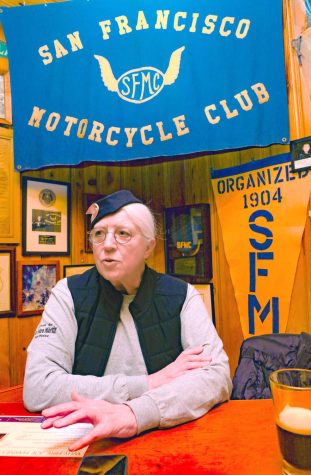
The current club president, Jane Williamson, is the second woman president in club history and currently serving in her second term. Presidents of the club are elected in December and serve a one-year term. Williamson joined the club in 2011 and welcomes everyone in with a kind demeanor. While presiding over club meetings, Williamson is all business. She leads the attending members through planned minutes and commands control of the room, and her stern voice can often be heard calling for members to be quiet. Keeping a rowdy group of friends at bay for up to an hour to discuss club concerns can be difficult, but it’s clear that all the members respect all the officers and value the work they contribute to keeping the club functioning.
“This was the first club of its kind to allow women to join,” Miriam Moody said. “And as a Latina woman who is now a member, that is very special to me.” Moody started out coming to meetings after befriending a member while getting her M1 motorcycle license. She started on a scooter and spent two years around the club before prospecting in 2019. Prospecting is an initiation period that happens in most clubs. The prospecting period is set by each individual club, and when the trial period is over, members are voted into the club.
“After my initial prospecting period, COVID hit, and pushed all club meetings online,” Moody said. “I was never officially initiated into the club because of lockdown, but today I am a full-time member and get to be officially initiated on the Easter Sunday ride.”
Shelly Waits, a current prospect and honorary member, had been around the club for over five years after a friend and member brought her to the clubhouse. Similar to Moody, Waits rode a scooter and recalls when she got her first motorcycle.
“The first thing I did after I got my bike was come to the clubhouse to show it off,” Waits said. “We are all like one big family, and I wanted to share the excitement of my first bike with them. And officially becoming a member with Jane as the President will be a memorable moment for me.”
Unlike most families, the SFMC is one of the most decorated and documented families. Titans of the industry have all embraced the blue and gold at one point or another, and many have participated on the national stage. Possibly the most well-known member was Lincoln Beachey, an American aviator. Orville Wright once said of Beachey: “An aeroplane in the hands of Lincoln Beachey is poetry. His mastery is a thing of beauty to watch. He is the most wonderful flyer of all.”
One of SFMC’s most historic moments came in 1937 when T.T. Racer Champion Loren “Hap” Jones wheeled his Indian motorcycle through the crowd of people looking to be the first to cross the Golden Gate Bridge at its opening. Jones, 32 at the time, kick-started his bike as the Golden Gate opened its causeway to pedestrians; he sped across to be the first person to make the 1.7-mile cruise north toward Marin. Jones’ legacy then skyrocketed, along with his business, as he became the first entrepreneur to start a nationwide supply chain of motorcycle parts.
His fame and love for motorcycles led him to begin his annual Hap Jones Birthday Party, a weekend trip of camping, open to all. The event was similar to all large rides, where riders congregate for a weekend of drinking, racing and enjoying each other’s company.
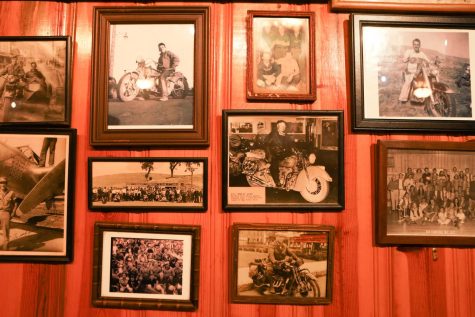
“Maniac” Dave Duran, a current member who has been around the club longer than any other, reminisced about the bike runs of years past.
“There are so many good memories,” Duran said. “In the early years, we would get together on Saturdays and have campouts and picnics. People would participate in bike games and just have a good time.”
Duran has been riding for 45 years and started riding with the Daly City Maniacs in 1970.
The Maniacs and the SFMC were always in good standing with each other, and would often hold functions together, according to Duran. But as decades passed, Duran found himself the lone member of the Maniacs.
“It was getting sad over there,” Duran said. “In the end, it was just me, and you can’t really be a president if you’re the only member of the club.” The last Maniacs patch now has a spot on the wall within the SFMC clubhouse.
As clubs and their runs grew in number, one Fourth of July run in 1947 drew the attention of the media. The American Motorcycle Association-sanctioned Gypsy Tour event in Hollister drew more riders than was expected. The social gathering turned into what is now known as the Hollister Riot or Hollister Invasion. According to Life magazine from 1947, the bikers caused a commotion in the small town roughly 80 miles south of San Francisco. At this time, motorcycle popularity boomed as World War II veterans returning to the U.S. banded together into MCs. Shortly after the event, the San Francisco Chronicle reported that bikers were damaging bars, throwing bottles out of windows and sleeping on hay bales outside of residents’ homes.
The cover of Life Magazine pictured a man on a motorcycle holding a beer surrounded by empty and broken bottles. However, SFMC records tell a different story.
“The photograph was staged,” Brian Holm said. “Photographers posed the man on a nearby bike, laid out beer bottles and snapped the photo that changed the image of motorcycle clubs forever.”
The San Francisco Chronicle published two stories on the event titled, “Havoc in Hollister and Hollister’s Bad Time”. Yet, Classic Bike, a motorcycle publication, had eyewitness testimony of the staged photograph from Gus Deserpa.
“I saw two guys scraping all these bottles together, that had been lying in the street. Then they positioned a motorcycle in the middle of the pile,” said Deserpa. “After a while this drunk guy comes staggering out of the bar, and they got him to sit on the motorcycle, and started taking his picture.”
The AMA issued a statement claiming, “the trouble was caused by the one percent deviant that tarnishes the public image of both motorcycles and motorcyclists.” This likely led to the one percenters ideology that is claimed by outlaw motorcycle clubs. Although the coverage of the event did alert the public to be on guard when motorcycle riders came through their towns, the SFMC walked away from the event with a Best Uniformed Club award. The trophy still sits in the clubhouse to this day.
In the same year of the Gypsy Tour ride, the SFMC blindly voted on the cost of a new clubhouse when Hap Jones placed a small retainer on an old blacksmith shop.
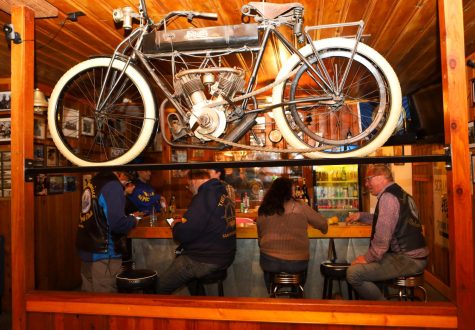
The building had just four walls and a roof when the club voted to purchase the property, which is why Jones did not want any member to see its condition before passing the vote. There was no foundation, dirt floors and was in no shape to hold a meeting. But understanding the value of a home, club members were quick to remodel the space to their liking. Today, the clubhouse has an unfinished wooden interior that emits a warm orange hue through the front gate. The club’s insignia lies at the entrance made of blue, yellow and white stone, and tables, couches and chairs are neatly facing the officers’ desk in the front left corner. A timeline of photographs cover the walls, detailing the club’s history and most influential members. At the back, a 1908 Curtis Motors motorcycle donated to the club hangs from the ceiling. Its original owner, H.L. Lausing, was one of SFMC’s early members and racers. Equipped with a kitchen and “fountain,” the clubhouse is a place where everyone can gather and spend time together.
Members of the club today talk of the importance of having a home base for the club. It gives each member a purpose to contribute to the club. Prospects looking to join the club spend their nearly 90-day initiation cleaning and maintaining the clubhouse. Waits says that she likes to take care of the clubhouse as though it were her own residence.
“I want people to walk in here and feel welcome, as if they were stepping into my own house,” Waits said.
On Easter Sunday 2023, Waits and the SFMC hosted visitors in their clubhouse. The San Jose Dons, Oakland Motorcycle Club and Capital City Motorcycle Club all came to 2194 Folsom St. to partake in the festivities.
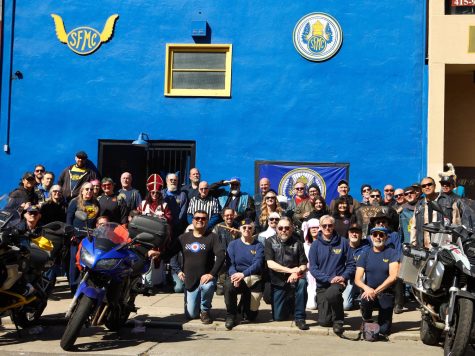
Moody and Robert Gonzales dressed as a Bishop and Nun to walk around and bless the bikes with sage, holy water and Harley-Davidson-branded bottled water. Other members set up an Easter egg hunt for those in attendance to win prizes, all while groups of people gathered to eat and admire each other’s bikes. Papa Schiller, one of the club’s longest-tenured members, with over 40 years, described the club as his life, and walking away from it now would be like turning his back on family.
Ultimately, that is what the club provides for so many: a place of belonging and people who they will forever call family.
Explore SFMC’s History Across San Francisco
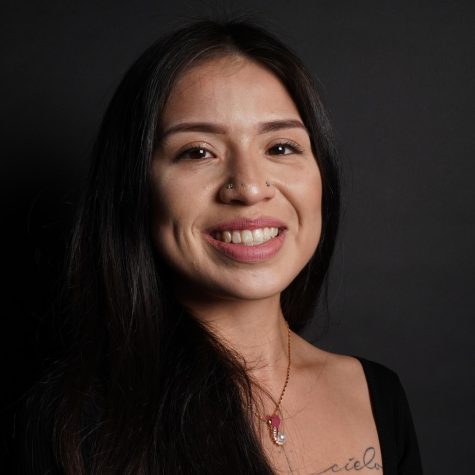
Gina Castro (she/her) is a staff photographer for Golden Gate Xpress. She is a Mexican-American photojournalism major and Africana studies minor. She...


